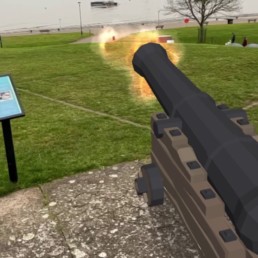New Tavern Fort
Defend the Thames against invaders at the New Tavern Fort.
Choose the Instagram or Facebook button below to open the AR experience.
Tap the ground to place your cannon. Use one finger to bring the cannon closer or further away, and two fingers to rotate it. Once you’re in position tap the cannon to fire at passing ships.
This experience will open your camera feed. Turn your sound on to enjoy the full experience.
History
Bristling with heavy guns, the New Tavern Fort is located on the south bank of the River Thames in the Fort Gardens at Gravesend. It is a reminder of an age when Britain and the states of Europe settled their disagreements with each other by force of arms.
The banks of the narrowing stretch of water known as Gravesend Reach were important for the siting of defences to oppose the way upstream to an enemy fleet and to prevent a landing.
For Britain, the risk of raiding or invasion during a period of war lead to a need to provide ports, coasts and strategic rivers with land-based defences as a second line behind the Navy.
As the maritime route to London, in which the political and economic life of the country was centred, the security of the Thames was the most important river to protect.
Defence of the Thames in time of war was vital for the security of the nation. By the 1530s around 80% of English exports passed along the river.
Artillery forts were first established here in 1539/40 under Henry V111’s national scheme of defence against a feared continental invasion. These were improved and supplemented by other works during the following centuries.
It was not until the 1780s that New Tavern Fort was added to this network of defences.
There were also important royal dockyards at Deptford and Woolwich to defend. The arsenal at Woolwich became the central store for England. By the 19th century London and the Thames had evolved into the hub of a burgeoning worldwide empire.
The Fort was retained as an active element of these defences until the early years of the 20th century. Its several stages of rebuilding and rearming allow us to trace the evolution of the defensive systems in response to international tensions and the developments in the technology of war over a period of 150 years.


